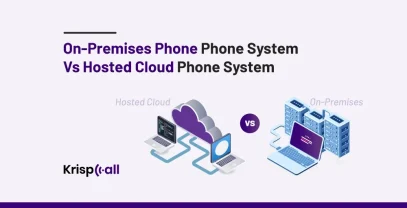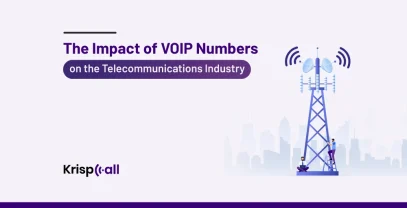Businesses that rely on VoIP or are considering switching to VoIP frequently inquire about the amount of VoIP bandwidth requirements to run any cloud-based phone system.
These VoIP phone systems require a stable Internet connection to handle inbound and outbound phone calls. So there are several things you should know about configuring your Network connection to have the optimum call quality.
In this article, you will briefly learn about the amount of voice over ip speed and the amount of bandwidth you need for your VoIP phone system.
What is Internet Bandwidth? 🤔
The volume of data that may be transported from one spot to another inside a network at a certain time is referred to as bandwidth. Generally, bandwidth is measured in bits per second and represented as a bitrate (bps).
Bandwidth is commonly confused with internet speed, although it refers to the quantity of data that can be delivered across a connection in a given amount of time.
Consider a high-bandwidth connection to be a six-lane freeway vs a two-lane freeway. The former has a higher capacity for traffic than the later.
Maximum bandwidth and Current Bandwidth (Water flowing through the pipe analogy)
Let’s say, water running through a pipe is an analogy for bandwidth.
The pace at which water (data) travels through the pipe under different conditions is referred to as bandwidth.
The maximum bandwidth is represented by the quantity of water that might conceivably flow through the pipe whereas the current bandwidth is represented by the amount of water that is now flowing through the pipe.
Unit of Measurement for Bandwidth
Originally, bandwidth was calculated in bits per second and represented as bps. However, today’s networks often have much more capacity than such small units. Higher figures with metric prefixes like Gbps (gigabits per second) or Mbps (megabits per second) are popular in the market.
| Prefix | Equivalent Number of Bits |
|---|---|
| Kilo | 1,000 bits |
| Mega | 1,000,000 bits |
| Giga | 1,000,000,000 bits |
| Tera | 1,000,000,000,000 bits |
Bytes per second is another way to express bandwidth. A capital B is typically used to represent bytes like MBps, GBps, etc.
Difference: Internet Bandwidth Vs Internet Speed
Internet bandwidth is the amount of data received per second whereas internet speed is the rate at which that data is received or downloaded.
For example,
While filling a bucket with water using a pipe. The rate of water flow depends on the thickness of the pipe. Here, the water acts as bandwidth and the rate of water flow acts as the Internet speed.
Measuring Your Internet Bandwidth
When people say they’re evaluating bandwidth, they’re usually referring to throughput. Most throughput tests employ a similar approach in which a series of packets are sent to a target and the response time is measured over a duration of time to obtain an average.
High bandwidth frequently equates to high throughput. However, like a six-lane motorway can have traffic jams that halt traffic, there are different variables that can reduce performance on a bandwidth network.
Numerous users using the same connection can reduce the speed of individual users.
TTCP (a throughput testing utility) or PRTG (a network monitor) provides visual representation. There is also a plethora of alternative bandwidth testing tools available.
Since not all broadband speed testing programs produce the same results, it’s advisable to use either ISP’s testing tool or a speed testing tool such as Ookla.
Does VoIP also work without an internet connection?
As the name suggests, Voice over Internet Protocol(VoIP) is useless without an active internet connection. In fact, VoIP requires a fast and stable internet connection to produce high-quality phone calls.
How do VoIP systems use bandwidth?
The amount of data that can be delivered across an internet connection in a given amount of time is referred to as bandwidth. Your ISP will allocate specific bandwidth for you according to your needs.
This is critical since VoIP phone conversations are made over the internet and require a strong internet connection to function properly. The amount of bandwidth accessible for your cloud-based phone system should be at least 100 kbps for good connectivity.
Lower bandwidth equates to slower speeds, which might lead to a reduction in call quality. The following are some of the factors that influence voice over IP calls:
- How many phone lines are required?
- How many calls will be occurring concurrently?
- Will other applications be running simultaneously with your VoIP system?
- Upload/download speed provided
- Codec provided by your service provider
This is where Voice over Internet Protocol (VoIP) enters the picture. By compressing and decompressing audio (voice) data, VoIP systems turn it into codecs. The codecs are then transmitted over the Internet to the other phone line.
You will require a minimum VoIP bandwidth from your network to accomplish this. It often requires greater bandwidth than is required to complete it swiftly and efficiently.
How Much VoIP Bandwidth Requirements is good enough for Quality VoIP Calls?
VoIP quality improves as bandwidth increases. The quantity of bandwidth necessary is determined by the number of calls you and your team will make at the same time. More concurrent calls necessitate additional bandwidth. If you’re utilizing VoIP for personal reasons, a bandwidth of 100 Kbps will get you over most of the difficulties.
We’ve developed a table representation for you to offer you considerably greater clarity on how much bandwidth is needed while also taking the number of active calls into account.
| Number of Concurrent Calls | Minimum Bandwidth Required | Ideal Bandwidth |
|---|---|---|
| 1 | 100 Kbps | 3 Mbps |
| 3 | 300 Kbps | 3 Mbps |
| 5 | 500 Kbps | 5 Mbps |
| 10 | 1 Mbps | 5-10 Mbps |
| 15 | 1.5 Mbps | 10+ Mbps |
| 20 | 2 Mbps | 10+ Mbps |
How to Troubleshoot VoIP Bandwidth Issues?
Do you have VoIP lagging (also known as voice delay) that makes you doubt your bandwidth? There are various troubleshooting options available to you.
1. Look into latency
Please remember that while some latency is to be expected with VoIP systems, excessive latency can cause problems for communications. Latency of between 150 and 300 milliseconds is considered “acceptable” or “normal” for VoIP systems. It’s regarded as “too much” if you have more than this margin.
2. Adjust QoS Settings
Generally, the Quality of Service (QoS) settings are embedded into Internet-connected devices through their routers. On the basis of your regular usage, you can “prioritize” bandwidth for specific devices over others.
If you use your phone system frequently, you should change these settings to allow enough bandwidth for VoIP. To effectively support VoIP, we recommend increasing QoS settings to the following:
- UDP/5060 – Priority: High
- UDP/6060 – Priority: High
- UDP/16384 to 32768 – Priority: High
3. Determine your type of Codecs
As previously stated, VoIP uses codecs in order to compress and decompress any data.
There are several types of codecs, each of which needs a certain amount of bandwidth to function.
It’s reasonable to think that your VoIP system uses codecs that necessitate a lot of bandwidth.
You should inquire about the codecs with your service provider. If this type isn’t right for your organization or consumes too much bandwidth, you might want to consider switching providers.
4. Upgrade your Bandwidth
The single best approach to gain the bandwidth necessary for VoIP is to purchase more bandwidth which will cost additional charges. Considering your Internet assists your business run on a daily basis, you should think of it as a good investment.
Increasing your bandwidth will enhance your connections in general allowing all of your Internet-connected devices to operate more quickly and smoothly.
5. Purchasing Bandwidth
Telecommunications companies are the most common source of bandwidth. The majority of consumers should have a minimum of 40 Mbps bandwidth for a good connection. The average cost of an internet package is USD 60.
Conclusion
Up until now, you may have realized how much bandwidth you need. The next step is to choose the best VoIP provider that offers quality VoIP services with powerful and advanced features at an affordable cost.
Look no further, KrispCall is here to help you with its VoIP cloud phone system and a Schedule Free KrispCall demo now for you to decide whether it’s the right choice for you or not.
At last, as we figured out, bandwidth is one of the important factors for increasing VoIP call quality. But, there are other important factors as well for improving VoIP call quality such as your network setup, jitter, and many more. So, you should consider looking at these factors affecting VoIP Call Quality while also keeping bandwidth in mind.
FAQs
1. Can I prioritize VoIP traffic on my network?
Yes, some routers offer Quality of Service (QoS) settings that prioritize VoIP data packets over other internet traffic. This ensures smoother call quality even when other online activities are happening.
2. What happens if my bandwidth isn’t enough?
Insufficient bandwidth can lead to several unpleasant experiences:
- Choppy audio: Your voice or the caller’s might sound broken or garbled.
- Delays and freezes: Conversations may become disjointed with noticeable pauses.
- Dropped calls: The connection might abruptly cut out during the call.
3. Are there tools or apps to optimize my network specifically for VoIP performance?
Indeed, there are programs and technologies available to help you optimize your network for VoIP. These instruments are capable of:
- Keep an eye on internet traffic: Determine the bandwidth hogs and bottlenecks affecting the VoIP quality.
- Prioritize VoIP data: To provide more seamless calls, make sure VoIP packets take precedence over other traffic.
- Set up the router’s settings: Adjust the router’s settings to get the best VoIP performance.
- Test and identify problems: Assist in resolving connectivity issues that impact the quality of calls.





